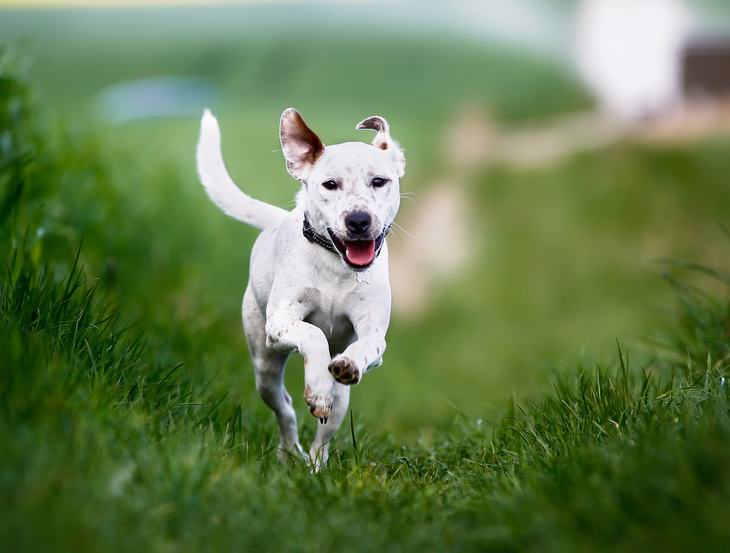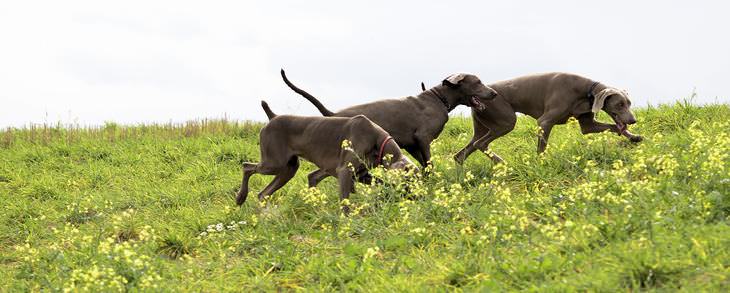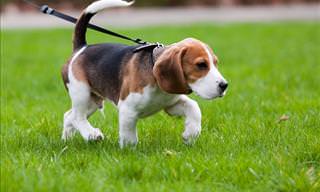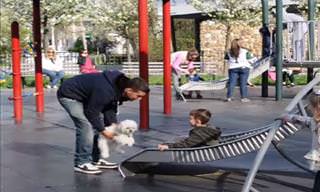

Full body wag
You're probably familiar with this wag, which you likely see whenever you come home from work. Here, your pup welcomes you with tail wagging in a big circle. He'll also shake his entire body in a loose way accompanied by a submissive grin or a soft open mouth. If you notice a lot of swaying and wiggly motion closer to the head of the dog, the friendlier the dog is.
Fast and shaky
If you notice fast, vigorous and an almost shaking tail on a dog this is a sign of tension and/or hostility. This means that the dog can spring into action at any moment. This tail behavior indicates a highly aroused dog and should generally be avoided until it settles down.
Slow wag
This can almost be seen on its face: your dog seems to be contemplating his next move. A slow wagging tail may indicate a dog that is unfriendly, so proceed with caution and take the entire environment and personality of the dog into consideration. If it's an unknown dog, do not interact with it.

High and stiff
A high and stiff tail with fast wagging means that the dog is alert and aroused. He is confident and enthusiastic. If other dogs are near it could mean a display of dominance. If a high stiff tail is combined with any teeth, open mouth, raised hackles and a wrinkled nose, take it as a cue to back off, providing them with space to make them feel comfortable and confident.
Wagin' on the right
Research suggests that when a dog wags its tail on the right side, it's considered more likely to be friendly than when a dog wags its tail on the left side of its body. Researchers discovered that dogs tend to wag their tails on the right when they wanted to approach something, like their owner, but wagged their tails on the left when they were unsure of something.
Pulled down
A tail that is held at a low level, often covering the dog's anus, but not disappearing between the legs, indicates that he is not entirely comfortable with the situation he is in and could be feeling anxious, nervous or unsure. A tail wag or wiggle may also indicate a sign of appeasement.

Tucked in
This is slightly different from a pulled down tail. When the tail is between its legs, the dog is feeling threatened or fearful of the situation he is in.
Curled toward the head
Prior to deciphering what this cue means, there are a few things to take into consideration. Some tails are naturally curled or bend towards the head, so the dog could be relaxed. But if the tail is being held (or pulled) in the direction of the dog's head, it could indicate the dog is overstimulated, on high alert, or highly excited. It could indicate alarm or exaggerated joy, which is why watching the rest of the body language the dog is showing you is important to understand how the dog is feeling.
Limp tail
A dog's tail serves a purpose. It is an extension of its backbone with vertebrae and a sensitive part of a dog's anatomy that is prone to injury. So if a dog's tail cannot wag it can mean that the dog has an injury directly to the tail, or to other connected areas. A tail can be sprained, broken, dislocated or have never damage that may cause it to go limp. It's important to seek immediate veterinary care as damage to the tail can cause incontinence, balance issues and the inability to use the tail to communicate.
What about stubby tails?
Breeds with stubby or curly tails mimic the same signals as those with straight or long tails but do not do so in the same exaggerated way as those with longer tails. Notice the base of the tail for more cues.

Here's How to Make Pretty Opaque Window Frosting!
If curtains aren't really your thing, then why not give opaque window frosting a chance? Here's how to make your own at home.

Discover the Effects of Drinking Dirty, Contaminated Water
How safe is it to drink contaminated water? Find out here.

Suffer From Knee Pain? Here Are 6 Moves You Can Do
Banish knee pain today with these 6 exercises.

Save Your Dog from Choking with This Emergency Maneuver
What do you do if you see a dog choking? This guide explains all you need to know.

Here's a Really Cheap & Easy Way to Clean a Stovetop
Looking for an effortless and cost-effective way of cleaning your stovetop? Then you've come to the right place.

These Remedies That Get Rid of Facial Hair Actually Work!
Got excess facial hair? Here are 7 natural remedies to remove it.
 8:53
8:53
Wow! Who Knew Kitchen Sponges Are So Versatile?
If you think that kitchen sponges can only be used for washing dishes, then, we’re sorry to say, you’re completely wrong. They're very versatile. Take a look!

Netflix Recommendations: Six Series to Enjoy This Summer
these are the most talked-about and anticipated new shows recently released or premiering summer of 2025.

Why You Should Be Adding Vinegar to Your Laundry
Here are 9 brilliant uses that vinegar has when it comes to doing the laundry.
 1:32
1:32
Got a Zipper Problem? Here's How You Can Fix It!
Got an issue with your zip? Here's what to do about it.

10 Financial Tips That Every Millionaire Has Long Known
Economically successful people don't rely on luck or fate. Heed these 9 tips to get on your way to achieving economic security.

Laundry Detergent Is SO Versatile: 8 Genius Home Uses
Laundry soap, both liquid and powder, has a great number of unexpected uses, from dissolving grease stains to cleaning upholstery & even getting rid of weeds!

10 Useful Guides to Help You With Your Clothes
10 useful guides to help you in your daily struggle with clothes.

These Cosmetic Products are Chemical Free & Cheap to Make
Ready-made cosmetics may be convenient, but not only are they expensive, they tend to contain toxic products. Here are 8 products you can prepare yourself.

I Bet You Never Realized How Useful Coffee Grounds Can Be!
Hold it! Don't throw away those old coffee grounds of yours - they have more uses than you can imagine. Read this post for 19 ways to use old coffee grounds.
 6:58
6:58
How to Make a Simple and Cheap Door Alarm!
Here's how you can save yourself some money by making your own door alarm at home.

These Leftover Foods Tips Will Save You Money!
We throw away an awful lot of food, but why throw leftover food away when it has so many great uses.
 28:22
28:22
Here’s Why Everyone Should Try 'No-Dig' Gardening
Grow plants year round with the no-dig gardening method.

Keep Insects Away With a Few All-Natural Bug Repellents
From bed bugs to spiders, these quick homemade bug repellents made from natural ingredients will help you keep them away.
 13:17
13:17
Learn the Best Sleeping Position to Relieve Neck Pain
aking up with neck pain? Your sleeping position might be to blame!

How to Get 8 Kinds of Unpleasant Smells Out of Clothes
Find out how to banish 8 of the most stubborn odors from clothes and other fabrics.

Warning! Don't Fall For These Common Marketing Tricks!
Here are ten common marketing ploys that you should be aware of, which will help you spend your money in a more informed manner.

How to Use Essential Oils Without An Expensive Diffuser!
Do you love essential oils, but you’re not ready to spend a lot of money on them or a diffuser? This article will help!

The 12 Perfect Rose Bushes for Beginner Gardeners
These wonderful roses require minimal maintenance, which makes them perfect for beginning gardeners!

5 Foods You Should NEVER Wash, and 5 You Absolutely MUST
Washing some foods can lead to the spreading of bacteria and other negative consequences. In this article you'll find 5 foods that you should never wash and 5 foods that you should always wash.

A Cheap and Easy Way to Remove a Scratch from Your Car
If you find a scratch on your car you can remove it yourself at home for just a couple of dollars. Here is how to do it.

Great Dog Training Tips You'll Wish You Knew Before!
Here are 10 great training secrets that will make it easier for you to train your puppy. Take a look.

7 Amazing Domestic Uses for Sugar
Most people think of sugar as just a sweetener, but it actually has many more uses! Here are 7 of them.

The Science Behind the Good Taste of Leftovers
Do you feel leftover food tastes different? it's not just in your head. Here's the science behind it, and which foods make the best leftovers.

Booking a Vacation? Watch Out for These 7 Online Scams
Booking your getaway? Keep it scam-free with these tips.
 4:40
4:40
This Is What Makes Duct Tape So Strong! Impressive
This is why duct tape is so strong!

This Guy Found a Tip Book from the 60s, And It's Genius!
It turns out lifehacks aren't only a thing of the present, the 60's had their own book of tips and tricks to make life easier, and here are 8 of the best!

7 Household Items You Could Be Using Wrong
The 7 everyday items on this list are all notoriously misused. Here's how to use them correctly.

6 Homemade Shampoos For Various Hair Types and Conditions
Anyone who isn’t happy with their current shampoo can try making homemade shampoo. This article offers 6 recipes and tips for making DIY shampoo.

8 Reasons Why You Should Always Have Shower Caps Handy!
Shower caps are a lot more useful than you could ever imagine. Take a look!

Make Your Headlights Look New Again Just Using Toothpaste!
Headlight oxidation is a common problem on modern cars. Here's how you can solve the problem.

9 Unexpected Uses of Your Vacuum Cleaner
Your vacuum cleaner has these unusual and surprisingly helpful advantages.

Never Put Your Phone in These 8 Common Places!
If you care about your cell phone and your health, then make sure you never leave your device in any of these places.

How to Clean 'Dry Clean Only' Clothes at Home
Dry cleaning can be a huge hassle, as well as quite the expense, which is why it is so much better to do it yourself at home...
 3:40
3:40
Shocking! You Must Watch This Video About Child Safety
This social experiment reveals a shocking fact about child safety in parks. You definitely need to watch this!

Dried vs. Canned Beans: Which Is the Better Option?
Can't decide between dried and baked beans? Here, we'll compare the two varieties and help you decide which option best suits your needs.

Why Wearing Flip Flops Is a Bad Idea For Your Health
What are the worst and the best types of footwear for summer weather? Here's a complete guide to summer footwear. Enjoy!

Fix Any Fence Problem With These 10 Video Tutorials!
10 video tutorials that'll cover most fence DIY issues, from fixing various issues to installation and painting.

What Is Your Attachment Style & How Does It Affect You?
Discover which of the following is your attachment style, with this helpful guide.

11 Gardening Myths That MUST Be Debunked
Some erroneous gardening myths managed to spread far and wide, despite being ineffective and even harmful. Here are 11 of such common gardening myths.

If Your Pet Has Fleas, Try Out These Natural Flea Remedies
Nature has provided us with many ways to eradicate fleas and we are going to share eight of them here. Take a look for yourself!

15 Unusual Uses For Onions That Won't Make You Cry
Onions are pretty amazing things. Not only do they make cooking taste much better, they also have 15 surprising household uses. You've never seen these before!
To enable your Ad-Free Subscription, please fill the fields below
Your subscription was successful, now you can enjoy an ad-free experience!! Note: To make sure you get no ads, please make sure to log in to your account. If you are logged in already, then refresh the page. The subscription can be cancelled at any time.


